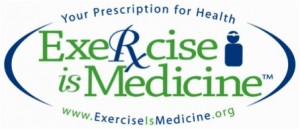By Liam West (@Liam_West) & Dr. Mike Loosemore
Undergraduate perspective on Sports & Exercise Medicine (a BJSM blog series)
The field of Sport & Exercise Medicine has two distinct areas. Namely, Exercise Medicine and Sports Medicine. To gain insights and get tips for students looking to follow in their footsteps, I interviewed two influential figures pushing the boundaries of each field.
The first of this two part interview series is with Dr. Mike Loosemore (ML) who is leading the “Exercise Is Medicine” initiative in the UK.

LW: Hi Dr. Loosemore. Could you describe to the undergraduate readers what Exercise Medicine entails?
ML: Exercise Medicine, or ‘Exercise Is Medicine’ as it’s promoted by the American College of Sports Medicine (ACSM), is the idea that exercise is important in preventing chronic non-communicable diseases (NCD) such as Type 2 diabetes mellitus, heart disease & cancer. Exercise can also be prescribed as a treatment for a NCD allowing the patient to simultaneously reap the additional benefits of regular moderate activity such as reducing co-morbidities and improving the patient’s sense of well being.
LW: So essentially undergraduates can view exercise as a more powerful treatment than handing out a single pill in many circumstances?
ML: Yes. Medical school essentially teaches students how to poison patients as that’s what you do by giving small doses of drugs; although obviously if you give them too much of the drug you poison them properly! It’s completely different with exercise. Using exercise we re-establish a natural process which allows the body to heal itself, returning it to the homeostatic state & often improving health considerable. Humans are exercising monkeys, we need to be active and if you don’t exercise enough important functions of your body start to degenerate!
LW: Powerful stuff! Would you be able to share with the readers some of the data surrounding exercise as a treatment for various NCDs?
ML: Here are some basic facts and figures for the undergraduates from the ACSM website. Regular physical activity reduces the;
- Risk of heart disease by 40%
- Incidence of diabetes by roughly 50%
- Risk of developing Alzheimer’s disease by 30%
- Incidence of high blood pressure by nearly 50%
- Risk of stroke by 27%
- Recurrence of breast cancer by almost 50%
- Risk of colon cancer by approximately 60%
- Depression as effectively as Prozac or Behavioural therapy
A pretty impressive intervention that has no medical equivalent that can do one of those things, never mind all of them! If you consider that medical inflation is going up significantly quicker than normal inflation and the population is ageing, we are reaching the edge of a financial cliff as far as healthcare costs are concerned. Currently the vast proportion of the NHS budget is spent on treating disease. Instead we should concentrate on preventing disease occurring in the first place which is relatively cheap! We cannot continue to be a disease service. It is called the National HEALTH Service not the National Disease Service!!!
LW: Hopefully that is a quote that will stick in the mind of many undergraduates! You have briefly touched upon some of the research, but are there any other resources students could use to find out about exercise medicine?
ML: I suggest they go to the ‘Exercise Is Medicine’ website where they can access lots of relevant resources & facts from evidence based research, read the BJSM blog and attend Sport & Exercise Medicine conferences, such as the Cardiff SEMS Olympic Conference 2012 on 15th December which is aimed primarily at undergraduates.
LW: Finally, if there was only one thing that we could do during our undergraduate career to spread the message of Exercise Medicine what would it be?
ML: Include it in your history paradigm. Every time you take history from a patient, ask about exercise. Two reasons for that;
- You will find out their individual activities levels and then can encourage them to do more. Any increase in exercise, no matter how small, will start to reduce the risks of chronic NCDs.
- A doctor asking about exercise sends a very powerful message to the patient and they clearly see that exercise is important.
LW: Thanks Dr. Loosemore for your expert opinion on Exercise Medicine and how undergraduate students can get involved.
*********************************************
Dr. Mike Loosemore MBBS DCH MRCGP MSc FFSEM(UK) is a Consultant in Sport & Exercise Medicine at the Institute of Sport, Exercise and Health, University College London. He is the lead Sports Physician (South of England) for the English Institute of Sport and currently the doctor to British Boxing. He is currently president of the Sports and Exercise Medicine section at the Royal Society of Medicine and leads the ‘Exercise is Medicine’ task force in the UK.
Liam West BSc (Hons) is a final year medical undergraduate student at Cardiff University, Wales. He coordinates the “Undergraduate Perspective on Sports & Exercise Medicine” Blog Series for BJSM.